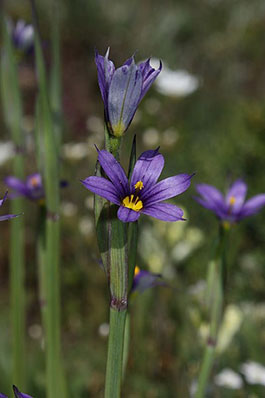Blue-Eyed Grass in the Landscape

Aaron Anderson, Oregon State University
Scientfic Name: Sisyrinchium idahoenseCommon Name: Idaho Blue-Eyed Grass
Description: Blue-eyed grass is a low maintenance, easy to grow perennial. This species is not a true grass, but rather a member of the Iris family. Growing from rhizomes, it forms clumps with mature plants reaching 6-18” tall. The grass-like leaves are long and thin (1/10” wide). Blue-eyed grass flowers are borne singly, and consist of six purple to blue tepals with a yellow base. Depending on the environment, this species will bloom from late spring through the middle of summer. It needs winter and spring moisture, though it can withstand summer dryness.
Native Habitat: Sisyrinchium idahoense is native to the western United States, and is found from northern California into British Columbia, and east from New Mexico into Montana. Found in open meadows, forests, and riparian areas in mountains at mid to high elevations (though it prefers subalpine environments).
Cultural Requirement
Soil: Grows in fine to coarse soil with a pH between 6.4 and 8.2. Prefers well drained sandy to loamy soil, but will tolerate some clay.
Moisture Tolerance: Requires winter-spring moisture, and grows well in seasonally saturated soils. In the wild, it is frequently found near wetland areas. Will tolerate dry soil in the summer, needing irrigation only around twice a month. Will also tolerate seasonal flooding.
Sun/Shade/Preference: Will grow in full sun to partial shade.
Transplanting: Grows well after transplanting. In fact, planting plugs is the recommended method of establishment in natural areas in order to allow young plants to outcompete weeds.
Propagation: Can be grown from seed. Seeds require stratification if grown indoors in pots. After sowing, keep above 65oF for 2-4 weeks, then move to below 45oF for 8 weeks. In December, pots should be moved to a greenhouse held at 50-60oF, and germination should occur within 4 weeks. In the field, seed can be sown directly in the fall for germination the following spring. Blue-eyed grass can also be propagated by dividing the root mass and replanting.
Maintenance (pruning, fertilization, deadheading, division, irrigation, etc): Requires little maintenance. Irrigation may be required to establish transplanted plugs, and may be required during summer when planted in drier soils
Insect, disease, or other problems: None known.
Landscape Value
Use in the Landscape: Good addition to a perennial wildflower garden, or in a wildflower border. Excellent candidate for meadow or pond-edge landscapes.
Weediness/Invasive Potential: Blue-eyed grass forms clumps, and will spread via rhizomes, albeit slowly. It will also readily self-seed, however it is not invasive and not likely to become weedy. Spread can be controlled by pulling volunteer plants in the spring, and cutting flowers before they go to seed.
Foliage: The foliage tends to form a distinct clump of basal leaves, with green to grey coloration. These leaves are long and narrow, about 1/10” wide, and like all monocots they exhibit parallel venation.
Flower: Solitary flowers borne on stems 6-18 inches tall. Flowers consist of six blue to violet tepals with a yellow base. Approximately 1 inch wide.
Timing: April-June.
Fruit: The fruit is a round capsule with three distinct segments (formed from the three connate ovaries). These capsules turn dark colored and split, ejecting numerous small (~1mm diameter) seeds.
Form: Forms a single crown of erect foliage.
Texture: Fine.
Ultimate Size: Plants are 6-18” tall.
Rate of Growth: Moderate growth rate. Foliage grows back every year after a period of winter dormancy or after mowing. Will bloom the first year of planting.
Suggested Plant Partners: Grows well with native grasses, Juncus spp., Allium spp., as well as under pine, maple, and Artemisia spp.
Availability: Starts available at some specialty native plant nurseries. Seed can be purchased from commercial native seed suppliers.
Cultivars: No known cultivars, but four varieties of Idaho blue-eyed grass occur. Var. occidentale and var. idahoense are distributed throughout the intermountain west, and var. idahoense is generally the most readily available from nurseries. Var. macounii (Macoun’s blue-eyed grass) is found only in Washington, and var. segetum is found only in Washington, Oregon, and Idaho
References:
Robson, K. A., Richter, A., & Filbert, M. Encyclopedia of Northwest native plants for gardens and landscapes. Timber Press, 2008.
Flora of North America Editorial Committee, Flora of North America North of Mexico vol. 26: Liliidae. New York and Oxford, 2002.
Graf, M. Plants of the Tahoe Basin: flowering plants, trees, and ferns: a photographic guide. Univ of California Press, 1999.
Harlow, N., & Jakob, K. Wild lilies, irises, and grasses: gardening with California monocots. Univ of California Press, 2003.
Beuthin, M. Plant guide for Idaho blue-eyed grass (Sisyrinchium idahoense). USDA-Natural Resources Conservation Service, Plant Materials Center, Corvallis, OR. 2012
Burke Museum of Natural History and Culture. WTU Image collection, 2018. Accessed Feb. 10, 2018 at http://biology.burke.washington.edu/herbarium/imagecollection.php?Genus=Sisyrinchium&Species=idahoense&Comp=Overview
Conservation Plant Characteristics for Sisyrinchium idahoense. Natural Resources Conservation Service. Accessed Feb. 10, 2018 at https://plants.usda.gov/java/charProfile?symbol=SIID
Sysyrinchium bellum California Native Plant Society, 2015 Accessed Feb. 10, 2018 at: https://jepson.cnps.org/horticulture/plant-of-the-month/21-sisyrinchium-bellum-february-2015
Sysyrinchium bellum California Native Plant Society, 2014. Accessed Feb. 10, 2018 at http://calscape.org/Sisyrinchium-idahoense-()
